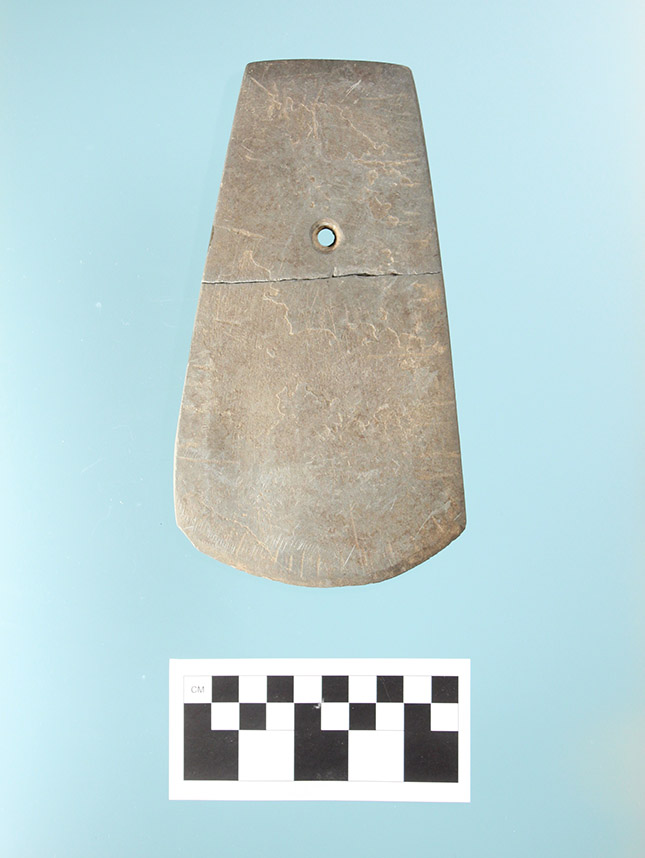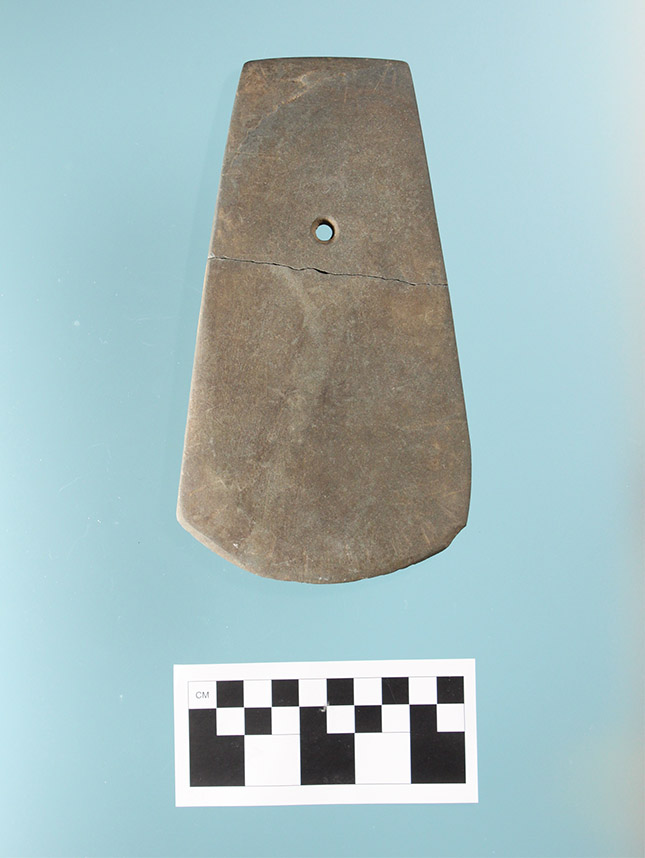By John H. House
Artifact of the Month - April 2018
Celts are a form of stone or metal axe blade produced in a variety of shapes. They typically lack the notched or indented haft elements found on many other kinds of axe blades, but are symmetrical both in plan and cross-section views. Secured to a handle, celts functioned both as woodcutting tools and as weapons. Native Americans living in Southeastern North America produced celts for many thousands of years, using a variety of stone types and native copper. However, special manufacturing treatments, including elaborate craftsmanship, perforation for suspension, and decoration, along with where they are found in archeological contexts, suggest that some celts were made specifically for display or ceremonial purposes.
Pictured is a perforated celt from site 3PR32 in Prairie County. It was found during fieldwork by University of Arkansas and the Arkansas Archeological Survey in 1981 after the site was discovered eroding out of the bank of White River.


DESCRIPTION
The specimen is 18.7cm in length, 10.3cm in width, and 1.1cm in thickness. The raw material is an unidentified gray, fine-grained micaceous sedimentary rock. The celt is fractured in two pieces from side to side just below the perforation. The celt’s outline is roughly trapezoidal with an excurvate (curving outward) blade or bit edge. It is rectangular in cross section. The surface is smoothly finished all over.
The perforation, located approximately one-third the distance from the butt end to the blade, is about 1.1cm in diameter on both faces, tapering slightly toward the center of the artifact. This suggests that it was made by drilling from both sides of the artifact. The bit edge exhibits grinding on both faces, converging to an edge angle of around forty degrees.
Aside from the perforation, the most conspicuous modifications are shallow carved lines extending perpendicularly from the side edges and radiating outward just above the bit edge. The lines are between 1 and 2mm in width, 5 to 30mm length, and a fraction of a millimeter in depth. They are only faintly visible in the photographs. Lines are present on both faces but there are more on the obverse face.
DISCUSSION
This perforated celt may be safely attributed to the Mississippian component at site 3PR32, dating between AD 1000 and 1600. The rectangular cross-section is characteristic of Mississippian celts generally. Perforated celts, often spatulate or spade-shaped in outline, occur infrequently in Mississippian contexts across the Southeast and are rare in Arkansas.
A perforated “ceremonial axe” very similar in size and proportions (19.4cm by 10.3cm and trapezoidal in outline) to the 3PR32 example was found by archeologist Clarence B. Moore in 1909 at Keno Plantation in Morehouse Parish, Louisiana. In characterizing the Keno artifact as a ceremonial axe, Moore noted that it was made of sandstone and, notwithstanding its sharpened edge, the object “. . . could stand but little rough use.” This would apply also to the 3PR32 example, which exhibits no indication of edge damage from use or resharpenings.
Artifact of the Month Series
A first principle of archeology is that the significance of artifacts depends upon documented information about the context of their discovery. At what site was the artifact found? Can we figure out the age of the artifact? Where was it found in relation to site features (houses, trash deposits, activity areas, etc.) and the distribution of other artifacts? Only with knowledge of those facts can we assess further information about the manufacture and use of artifacts, and their role in other spheres of activity such as social organization, trade and exchange, and religious practice.
In this series, we feature select artifacts that are extraordinary both for the context of their discovery and for their unique qualities that contribute exceptionally important information about Arkansas culture and history. New artifacts will be added monthly throughout 2018. Find the list of artifacts here.
 Collections and items in our institution have incomplete, inaccurate, and/or missing attribution. We are using this notice to clearly identify this material so that it can be updated, or corrected by communities of origin. Our institution is committed to collaboration and partnerships to address this problem of incorrect or missing attribution. For more information, visit localcontexts.org.
Collections and items in our institution have incomplete, inaccurate, and/or missing attribution. We are using this notice to clearly identify this material so that it can be updated, or corrected by communities of origin. Our institution is committed to collaboration and partnerships to address this problem of incorrect or missing attribution. For more information, visit localcontexts.org.
 The Arkansas Archeological Survey is committed to the development of new modes of collaboration, engagement, and partnership with Indigenous peoples for the care and stewardship of past and future heritage collections.
The Arkansas Archeological Survey is committed to the development of new modes of collaboration, engagement, and partnership with Indigenous peoples for the care and stewardship of past and future heritage collections.
 The TK Notice is a visible notification that there are accompanying cultural rights and responsibilities that need further attention for any future sharing and use of this material. The TK Notice may indicate that TK Labels are in development and their implementation is being negotiated. For more information about the TK Notice, visit localcontexts.org.
The TK Notice is a visible notification that there are accompanying cultural rights and responsibilities that need further attention for any future sharing and use of this material. The TK Notice may indicate that TK Labels are in development and their implementation is being negotiated. For more information about the TK Notice, visit localcontexts.org.
